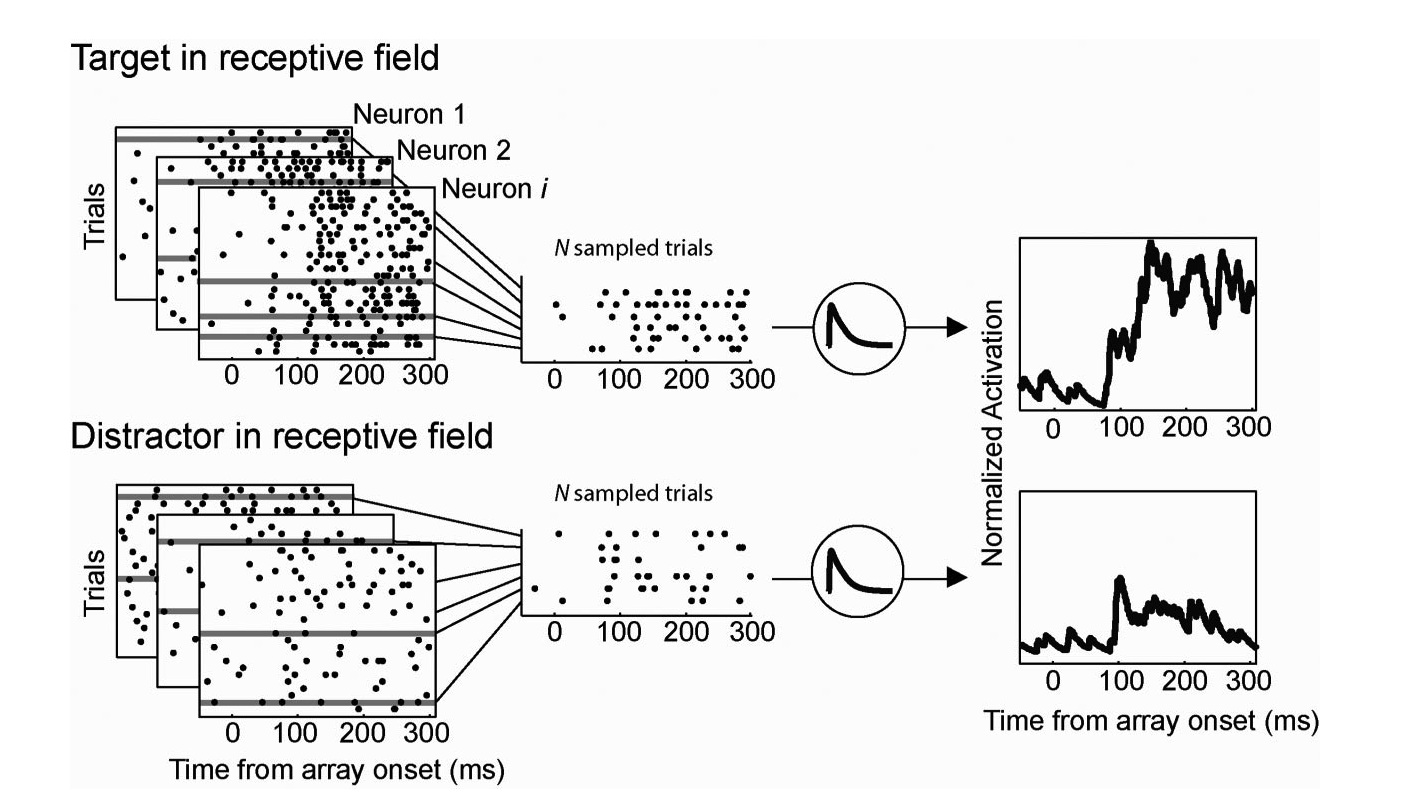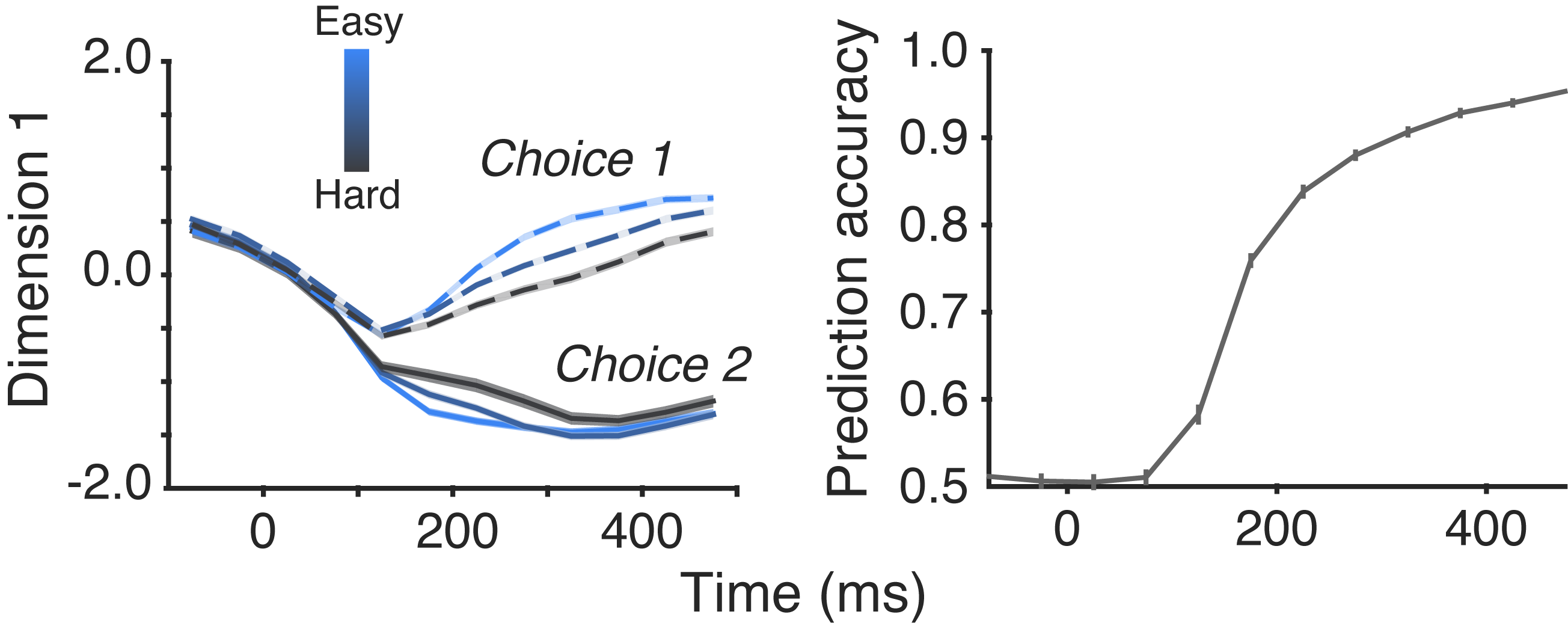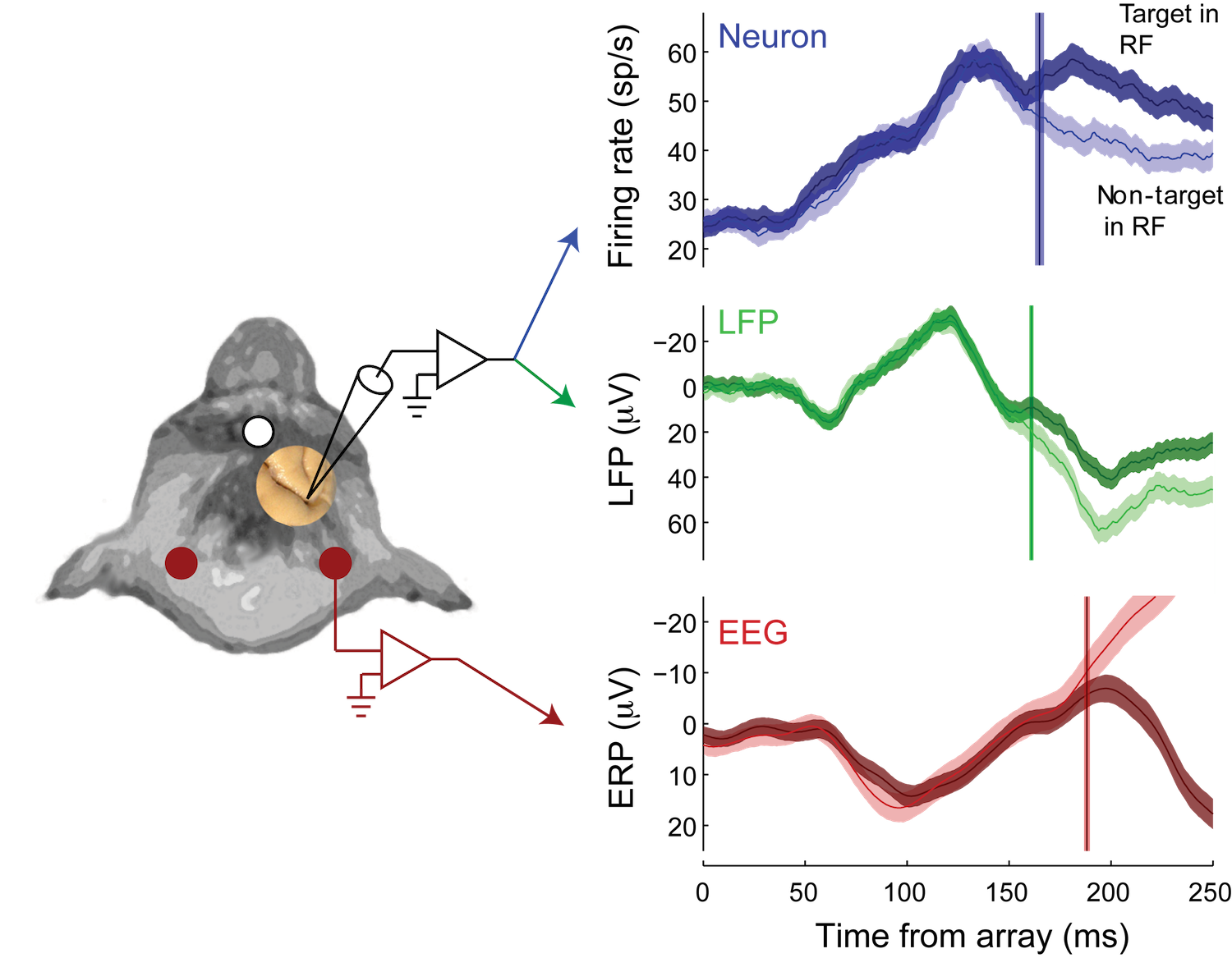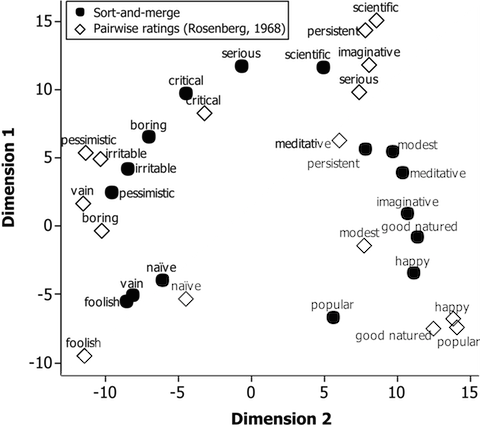I study how the brain combines different types of information to make decisions. I develop models that explain the computations that support decision making and design behavioral experiments to validate model predictions. I test how the brain could implement those computations by recording from large populations of neurons and use machine-learning algorithms to visualize neural states and predict upcoming choices.
Neural Models of Decision Making
I developed neural computational models of decision making for my PhD thesis. My models use neural time-series data recorded from macaque monkeys making visual decisions as input to shallow artificial neural networks. The models predict the monkey’s choices and response times and reproduce the dynamics of actual neural populations. You can find an overview the modeling framework and sample code in the gated_accumulator_model repository or read more about the details in the papers listed below.
Collaborators: Thomas Palmeri, Jeffrey Schall, Gordon Logan, Richard Heitz, Jeremiah Cohen (Vanderbilt University)

Figure 1. Using actual neural data to generate input to decision-making networks. Check out the gated_accumulator_model repository or Purcell et al. 2010 for more details.
Papers
- Purcell, B. A., Heitz, R. P., Cohen, J. Y., Schall, J. D., Logan, G. D., & Palmeri, T. J. (2010). Neurally constrained modeling of perceptual decision making. Psychological review, 117(4), 1113.pdf
- Purcell, B. A., Schall, J. D., Logan, G. D., & Palmeri, T. J. (2012). From salience to saccades: multiple-alternative gated stochastic accumulator model of visual search. Journal of Neuroscience, 32(10), 3433-3446.pdf
- Purcell, B. A., & Palmeri, T. J. (2017). Relating accumulator model parameters and neural dynamics. Journal of Mathematical Psychology, 76, 156-171.pdf
- Schall, J. D., Purcell, B. A., Heitz, R. P., Logan, G. D., & Palmeri, T. J. (2011). Neural mechanisms of saccade target selection: gated accumulator model of the visual–motor cascade. European Journal of Neuroscience, 33(11), 1991-2002.pdf
- Zandbelt, B., Purcell, B. A., Palmeri, T. J., Logan, G. D., & Schall, J. D. (2014). Response times from ensembles of accumulators. Proceedings of the National Academy of Sciences, 111(7), 2848-2853.pdf
In the news
Models of Adaptive Decision Making
I combined human psychophysical experiments, computational models of behavior, and neurophysiological recordings from behaving macaque monkeys to understand how we adapt our decision strategies following mistakes. I fit models of choice and reaction time to human and monkey behavior and optimized model parameters to make inferences about the underlying neural mechanisms. To test the model predictions, I analyzed neural dynamics recorded from the parietal cortex of monkeys performing a perceptual decision-making task. The neural data matched the model predictions and showed that although our visual sensitivity drops following errors, our brain can compensate by adaptively slowing down the subsequent choice. You can read more about it in the following paper or check out some of the popular press on the article by following the links below.
Collaborator: Roozbeh Kiani (New York University)

Figure 2. Decision errors slow us down (Left). We found that neural activity in parietal cortex also changes (Middle). Our computational modeling explains why this happens (Right). Check out Purcell & Kiani (2016) for more details.
Paper
- Purcell, B. A., & Kiani, R. (2016). Neural mechanisms of post-error adjustments of decision policy in parietal cortex. Neuron, 89(3), 658-671.pdf
In the news
I developed a new computational model to understand flexible decision making in a dynamic environment. In a changing environment, we must decide whether errors result from poor choices or a change in the environment. The Bayes optimal solution is to treat negative outcomes as evidence for a change of environment and to weight that evidence by the confidence in our choice. I developed a model that showed how humans could approximate the optimal solution using very simple computations and developed a psychophysics experiment to test the model predictions. I showed that the model accurately predicts human choices and quantitatively outperforms plausible alternatives.
Collaborator: Roozbeh Kiani (New York University)

Figure 3. A computational model explains decisions based on a visual information (Left) and changes of environment (Middle). The model explains how accumulation of visual evidence maps to confidence, which in turn provides evidence for changes of environment (Right). See Purcell & Kiani (2016b) for more details.
Paper:
- Purcell, B. A., & Kiani, R. (2016). Hierarchical decision processes that operate over distinct timescales underlie choice and changes in strategy. Proceedings of the National Academy of Sciences, 113(31), E4531-E4540.pdf
In the news
Predicting Choices from Large-Scale Neural Recordings
I use state-of-the-art electrophysiology technology to simultaneously record activity from hundreds of neurons in multiple areas of the primate brain. I record neural activity while monkeys make decisions based on visual information. I use dimensionality reduction methods to visualize the evolution of neural states during decision formation. I use linear classifiers to decode the information represented in different brain region and to predict the upcoming choices. I study the correlation structure of signals within and across areas to to understand neural interactions. My results from this project will be presented at the Society for Neuroscience Annual Meeting this fall.
Collaborator: Roozbeh Kiani (New York University)

Figure 4. (Left) I used unsupervised dimensionality reduction techniques (Yu et al., 2009) to visualize the evolution of neural states over time. The network evolves to signal the upcoming choice, and the signal is stronger for easier decisions. (Right) A linear classifier trained on 20 dimensions can decode the upcoming choice with >95% accuracy (cross-validated).
Neurophysiological Representations of Visual Salience
In two studies, I recorded activity from neurons in medial and lateral frontal cortex of monkeys trained to perform a visual search task in which they located a target item among distractors (e.g., red circle among green circles). I used auROC curves and other analyses to quantify the information about object identity carried by individual neurons. I found that lateral frontal cortex robustly represents the location of the target, but medial frontal corext did not. Instead, medial frontal cortex seems to play a role in signaling feedback.
Collaborators: Polly Weigand, Jeffrey Schall, Richard Heitz, Jeremiah Cohen (Vanderbilt University)

Figure 5. (Left) Example neurons from lateral and medial frontal cortex. Only the lateral neuron signals the target location (red shading). (Right) An auROC analysis indicates that lateral frontal neurons signal significantly more information about target location. See Purcell et al. (2012) for more details.
Papers
- Purcell, B. A., Weigand, P. K., & Schall, J. D. (2012). Supplementary eye field during visual search: salience, cognitive control, and performance monitoring. Journal of Neuroscience, 32(30), 10273-10285.pdf
- Purcell, B. A., Heitz, R. P., Cohen, J. Y., & Schall, J. D. (2012). Response variability of frontal eye field neurons modulates with sensory input and saccade preparation but not visual search salience. Journal of neurophysiology, 108(10), 2737-2750.pdf
Homologous Neural Mechanisms of Visual Attention and Working Memory in Humans and Non-Human Primates
I collaborated with Goeff Woodman to conduct two studies of electroencephalogram (EEG) recordings - brain activity recorded from the surface of the head that can be used to index cognitive states. My work helped to establish a non-human primate model of EEG components associated with visual attention and working memory. By pairing EEG from outside the skull with recordings of neural activity from inside the brain, we could study how neural activity gives rise to observed EEG. We showed how frontal cortex indirectly contributes to the generation of attention and memory related EEG signals. You can read more about this work in the papers below or check out Geoff’s website for more information about his awesome work.
Collaborators: Geoff Woodman, Rob Reihardt, Jeffrey Schall, Richard Heitz, Polly Weigand (Vanderbilt University)

Figure 6. Example neuron (top, blue), local field potential (middle, green), and EEG (bottom, red) recorded from a macaque monkey performing a visual search task. All three signals indicate the location of the search target. See Purcell et al. (2013) for more details.
Papers
- Purcell, B. A., Schall, J. D., & Woodman, G. F. (2013). On the origin of event-related potentials indexing covert attentional selection during visual search: timing of selection by macaque frontal eye field and event-related potentials during pop-out search. Journal of neurophysiology, 109(2), 557-569.pdf
- Reinhart, R. M., Heitz, R. P., Purcell, B. A., Weigand, P. K., Schall, J. D., & Woodman, G. F. (2012). Homologous mechanisms of visuospatial working memory maintenance in macaque and human: properties and sources. Journal of Neuroscience, 32(22), 7711-7722.pdf
Evaluating Methods for Measuring and Visualizing Human Similarity Judgments
As an undergraduate, I evaluated methods for visualizing the structure of human categorization of colors and personality traits. I collected human similarity judgments of color and personality trait stimuli using a “sort-and-merge” procedure in which subjects grouped stimuli into clusters based on their perceived similarity and subsequently merged the clusters based their overall group similarity. I visualized the resulting similarity structure using an multidimensional scaling (MDS) procedrue. I assessed the internal validity of the procedure using percent variance explained and the external validity of the procedure by comparing the shape of the solution to a “ground truth” dataset obtained using pairwise similarity judgments. I found that the sort-and-merge procedure could capture the structure of judgments quite well, establishing it as a cheaper and less time-consuming alternative to pairwise judgments for measuring human categorization.
Collaborator: Robin Thomas (Miami University)

Figure 7. First two dimensions of the MDS solution for personality trait data collected with sort-and-merge procedure compared to pairwise similarity judgments. Both methods generally agree and reveal the structure of human categorization.